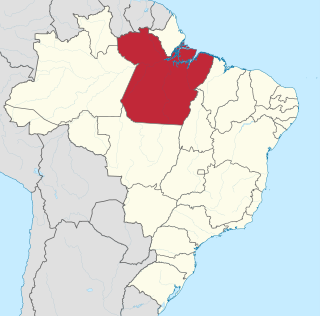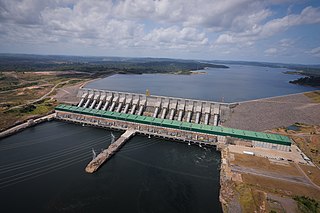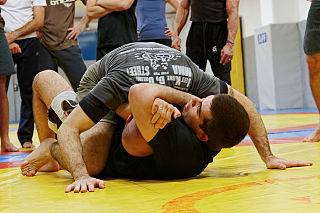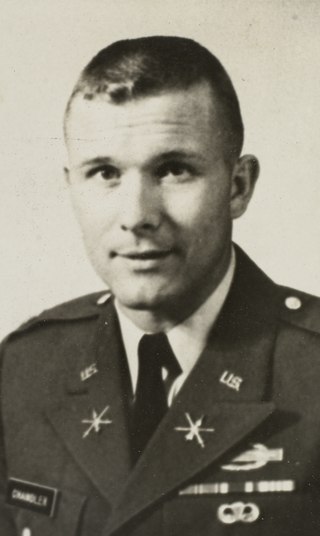
Indigenous peoples in Brazil or Indigenous Brazilians once comprised an estimated 2000 tribes and nations inhabiting what is now the country of Brazil, before European contact around 1500.

Pará is a state of Brazil, located in northern Brazil and traversed by the lower Amazon River. It borders the Brazilian states of Amapá, Maranhão, Tocantins, Mato Grosso, Amazonas and Roraima. To the northwest are the borders of Guyana and Suriname, to the northeast of Pará is the Atlantic Ocean. The capital and largest city is Belém, which is located at the Marajó bay, near the estuary of the Amazon river. The state, which is home to 4.1% of the Brazilian population, is responsible for just 2.2% of the Brazilian GDP.
Orlando (1914–2002) and his brothers Cláudio (1916–1998) and Leonardo Villas-Bôas (1918–1961) were Brazilian brothers who worked in indigenous activism. In 1961 they succeeded in getting the entire upper Xingu legally protected, making it the first massive indigenous area in all South America, and the prototype for dozens of similar reserves all over the continent.

The Fundação Nacional dos Povos Indígenas or FUNAI is a Brazilian governmental protection agency for Amerindian interests and their culture.

The Kamayurá are an indigenous tribe in the Amazonian Basin of Brazil. Their name is also spelled Kamayura and Kamaiurá; it means "a raised platform to keep meat, pots and pans." The Kamayurá language belongs to the Tupi–Guarani family.
The Panará are an Indigenous people of Mato Grosso in the Brazilian Amazon. They farm and are hunter-gatherers.
The Xingu Indigenous Park is an indigenous territory of Brazil, first created in 1961 as a national park in the state of Mato Grosso, Brazil. Its official purposes are to protect the environment and the several tribes of Xingu indigenous peoples in the area.

The Belo Monte Dam is a hydroelectric dam complex on the northern part of the Xingu River in the state of Pará, Brazil. After its completion, with the installation of its 18th turbine, in November 2019, the installed capacity of the dam complex is 11,233 megawatts (MW), which makes it the second largest hydroelectric dam complex in Brazil and the fifth largest in the world by installed capacity, behind the Three Gorges Dam, Baihetan Dam and the Xiluodu Dam in China and the Brazilian-Paraguayan Itaipu Dam. Considering the oscillations of flow river, guaranteed minimum capacity generation from the Belo Monte Dam would measure 4,571 MW, 39% of its maximum capacity.
The Amazon Military Command is one of eight Military Commands of the Brazilian Army. The Amazon Military Command is responsible for the defence of the Amazon Basin. Four Infantry Brigades specializing in Jungle warfare, one construction Engineer Brigade and one Military Regional Command are subordinated to the CMA. Its area of responsibility covers the states of Amazonas, Acre, Roraima and Rondônia.
The Southeastern Military Command is one of eight Military Commands of the Brazilian Army. It is responsible for the defence of the state of São Paulo.
The Southern Military Command is one of eight Military Commands of the Brazilian Army. The Southern Military Command is responsible for the defence of the states of Rio Grande do Sul, Paraná and Santa Catarina.
Heinz Budweg is a German painter who currently resides in Sao Paulo, Brazil. Budweg is considered the best living artists in the speciality of painting the Indians of the Amazon Forest.
Yamurikuma is a festival in which the women of some Xingu tribes participate in a sort of gender role reversal, wearing feather ornaments and ankle rattles normally worn by men. There are several physical competitions, including archery, swimming, carrying logs, running, and tug of war.
Jean-Pierre Dutilleux is a Belgian author, activist, film director, actor and editor of films.

Raoni Metuktire, also known as Chief Raoni or Ropni, is an Indigenous Brazilian leader and environmentalist. He is a chief of the Kayapo people, a Brazilian Indigenous group from the plain lands of the Mato Grosso and Pará in Brazil, south of the Amazon River and along Xingu River and its tributaries. He is internationally famous as a living symbol of the fight for the preservation of the Amazon rainforest and indigenous culture.

Xingu is a 2011 Brazilian drama film directed by Cao Hamburger and scripted by him, Elena Soárez and Anna Muylaert. Starring João Miguel, Felipe Camargo and Caio Blat, the film tells the Villas-Bôas brothers trajectory from the moment in which they joined the Roncador-Xingu expedition, part of the Westward March of Getúlio Vargas, in 1943.

Luta Livre, known in Brazil as Luta Livre Brasileira or Luta Livre Submission, and also Brazilian Submission Wrestling, is a Brazilian martial arts and combat sport created by Euclydes Hatem in Rio de Janeiro. Primarily a mixture of catch wrestling and kosen judo, there is also ground striking with the hands, feet, knees and elbows. Notable practitioners include Marco Ruas, Ebenezer Fontes Braga, Johil de Oliveira, Alexandre Franca Nogueira, Renato Sobral, Gesias Cavalcante, Pedro Rizzo, Darren Till and José Aldo.

Sônia Bone de Souza Silva Santos, usually known as Sônia Guajajara, is a Brazilian indigenous activist, environmentalist, and politician. A member of the Socialism and Liberty Party (PSOL), she was initially a candidate for President of Brazil in the 2018 Brazilian general election, before being chosen as the vice presidential running mate of nominee Guilherme Boulos. This made her the first indigenous person to run for a federal executive position in Brazil. In 2022, Guajajara was named one of the 100 most influential people in the world by Time.
Corumbiara is a 2009 Brazilian documentary film, directed by Vincent Carelli. The film won three awards at 37th Gramado Film Festival including Best Picture.

Charles Rodney Chandler was a US Army officer and veteran of the Vietnam War assassinated by members of the Vanguarda Popular Revolucionária (VPR) and the Ação Libertadora Nacional (ALN) in São Paulo, Brazil.









